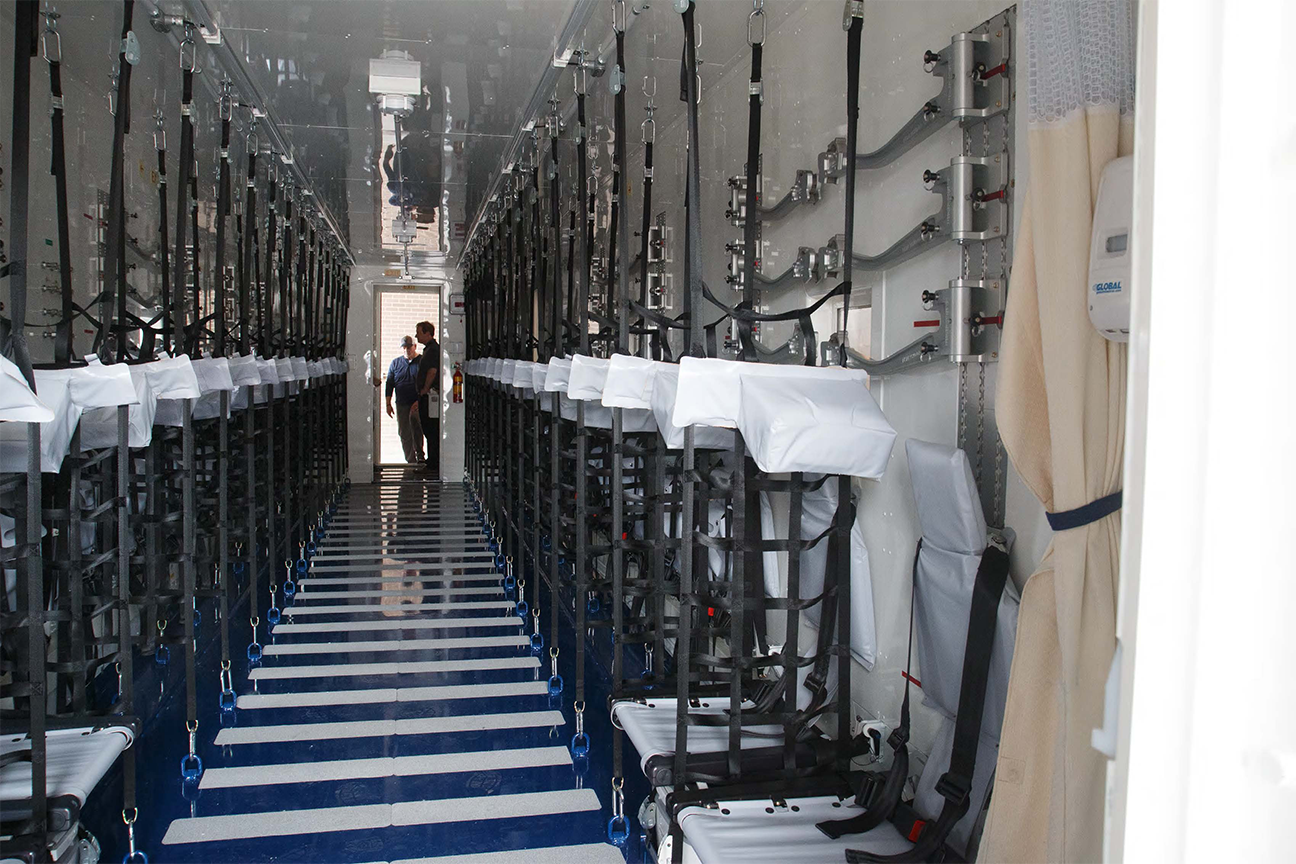WRIGHT-PATTERSON AIR FORCE BASE, Ohio (AFRL) — An essential piece of equipment arrived at the Center for Sustainment of Trauma and Readiness Skills, or C-STARS, in Omaha, Nebraska, June 24, 2023. The Negatively Pressurized CONEX, or NPC, will be utilized in developing a new infectious disease air transport training course on procedures for current and future outbreaks of high-consequence infectious diseases, or HCIDs.
C-STARS Omaha is a training program through the United States Air Force School of Aerospace Medicine or USAFSAM, in collaboration with the University of Nebraska Medical Center. USAFSAM is headquartered at Wright-Patterson Air Force Base in Dayton, Ohio, and is part of the Air Force Research Laboratory’s 711th Human Performance Wing.
“We’re developing the only infectious disease air transport training platform in the DOD.,” said Robert Valentine, administrator of C-STARS Omaha. “We’re at the leading edge of this technology. We’ve been tasked to develop the CONOPS [concept of operations] for high-consequence infectious disease patient transport.”

The Negatively Pressurized CONEX, or NPC, arrives at the Center for Sustainment of Trauma and Readiness Skills, or C-STARS, in Omaha, Nebraska June 24, 2023. The NPC will be used in developing a new infectious disease air transport training course on procedures for current and future outbreaks of highly infectious disease (U.S. Air Force photo)
The NPC will also allow the C-STARS team to train personnel on donning and doffing procedures for personal protective equipment in confined spaces and safely moving patients into and out of the unit.
“Right now, the CONOPS for the NPC are COVID-specific,” said Maj. Tiffany Welsh, deputy director of C-STARS Ohama. “The CONOPS that would cover high-consequence infectious diseases have not been solidified, and there are still gaps to work through.”
The new C-STARS NPC is a modified shipping container converted into a clinical space with air handling and medical equipment to transport patients exposed to or infected by high-consequence infectious diseases, or HCIDs. The NPCs transport HCID patients on military aircraft, like C-17s, to get needed medical attention more rapidly. There is also an NPC-Lite version designed to be used on a C-130.

The Negatively Pressurized CONEX, or NPC, arrives at the Center for Sustainment of Trauma and Readiness Skills, or C-STARS, in Omaha, Nebraska June 24, 2023. The NPC will be used in developing a new infectious disease air transport training course on procedures for current and future outbreaks of highly infectious disease (U.S. Air Force photo)
“[The NPC] we received was right off the production line,” said Welsh. “It was brand new with all of the requested modifications.”
According to Valentine, the origin of the NPC can be traced back to the Ebola outbreak in West Africa in 2014 when Air Mobility Command, or AMC, developed the Transport Isolation System, or TIS, when United States Africa Command needed the capability to move people exposed to or infected by Ebola out of the African theater of operations so they could receive needed medical care in the continental United States.
“There was a need to transport patients with high-consequence infectious diseases,” said Valentine. “That evolved with the outbreak of COVID. Only one or two patients could be put on a TIS, so the Negatively Pressurized CONEX was developed for COVID operations.”
In 2020, AMC developed the NPC to respond to the need for more high-capacity movement of patients from deployed locations. The mission aims to move exposed or infected HCID patients while minimizing the risk to civilians, aircrew, medical attendants and the airframe.
There are NPCs located at Travis, Dover, Germany, Japan and Qatar according to Welsh. Locations where there the squadrons are most likely to use the NPCs, and there are teams trained on how to move patents.

Interior of the Negatively Pressurized CONEX, or NPC at the Center for Sustainment of Trauma and Readiness Skills, or C-STARS, in Omaha, Nebraska June 24, 2023. The NPC will be used in developing a new infectious disease air transport training course on procedures for current and future outbreaks of highly infectious disease (U.S. Air Force photo)
Negatively pressurized chambers are commonly used as a method of infection control to isolate patients with contagious, airborne diseases such as measles, tuberculosis or coronavirus. The air pressure inside the chamber is kept lower than outside, preventing potentially contaminated air and other dangerous particles from escaping outside into non-contaminated areas.
Instead, the potentially contaminated air is removed with exhaust systems, using filters that clean the air before it is pumped outside and away from the healthcare facility.
For more information on C-STARS Omaha and infectious disease training, visit https://afresearchlab.com/technology/successstories/infectious-disease-training/
About AFRL
The Air Force Research Laboratory, or AFRL, is the primary scientific research and development center for the Department of the Air Force. AFRL plays an integral role in leading the discovery, development and integration of affordable warfighting technologies for our air, space and cyberspace force. With a workforce of more than 11,500 across nine technology areas and 40 other operations across the globe, AFRL provides a diverse portfolio of science and technology ranging from fundamental to advanced research and technology development. For more information, visit www.afresearchlab.com.

